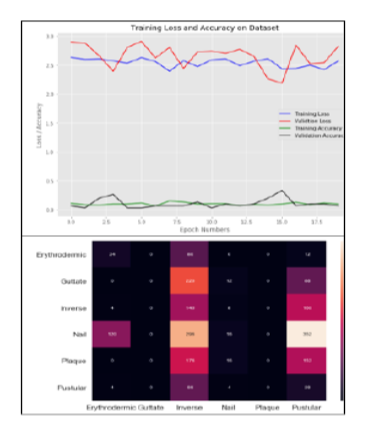


Indian Journal of Science and Technology
DOI: 10.17485/IJST/v15i13.2297
Year: 2022, Volume: 15, Issue: 13, Pages: 561-569
Original Article
T R Arunkumar1*, H S Jayanna2
1Research Scholar, Department of Computer Science & Engineering, Siddaganga Institute of Technology, Tumkur, India
2Professor and Head, Department of Information Science, Siddaganga Institute of Technology, Tumkur, India
*Corresponding Author
Email: [email protected]
Received Date:08 December 2021, Accepted Date:30 December 2021, Published Date:25 March 2022
Objectives: The main objective of the work is to classify the psoriasis affected skin into one of different psoriasis types viz. erythrodermic, gutatte, inverse, nail, plaque, and pustular using depth wise separable convolution neural networks. Methods: To identify the type of psoriasis disorder, the experiment uses MobileNet machine learning architecture which is based on depthwise separable convolutions. In the preprocessing step, the input images are segmented into 224 pixels X 224 pixels with the help of the keras KerasImageDataGenerator function and in next step, these segmented images are fed as input to 28 layers of reconstructed MobileNet architecture. A series of convolutions and depth-wise separable convolutions layers are applied on the input images. The rectified linear activation function is applied to introduce non-linearity in the network. Adam optimizer algorithm is used for training the network. Categorical cross-entropy is used for the comparison of the accuracy of the experimental results with the existing work of classification of psoriasis disorder. Findings: Using MobileNet machine learning architecture, the experiments attained around 86% of classification efficiency, and an average F1 score of .94 as compared with VGG19 and ResNet-34, compared to the work done in(1). Novelty: The novelty of the work lies in the prediction of the types of the psoriasis disorder accurately with less turnaround time with an accuracy of 86% consuming low processing capability which can be implemented on low powered hand-held devices.
Keywords: Machine Learning; Depth Wise Separable Convolution; Psoriasis Disorder; ReLU Activation; Pointwise convolutions
© 2022 Arunkumar & Jayanna. This is an open-access article distributed under the terms of the Creative Commons Attribution License, which permits unrestricted use, distribution, and reproduction in any medium, provided the original author and source are credited.
Published By Indian Society for Education and Environment (iSee)
Subscribe now for latest articles and news.